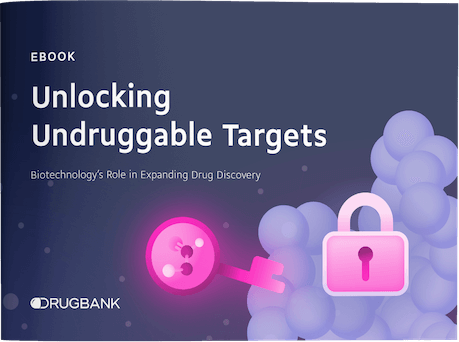Explore a selection of our essential drug information below, or:
Identification
- Generic Name
- 4-[3-(3-NITROPHENYL)-1,2,4-OXADIAZOL-5-YL]BUTANOIC ACID
- DrugBank Accession Number
- DB07498
- Background
Not Available
- Type
- Small Molecule
- Groups
- Experimental
- Structure
- Weight
- Average: 277.2328
Monoisotopic: 277.069870477 - Chemical Formula
- C12H11N3O5
- Synonyms
- Not Available
Pharmacology
- Indication
Not Available
 Reduce drug development failure ratesBuild, train, & validate machine-learning modelswith evidence-based and structured datasets.Build, train, & validate predictive machine-learning models with structured datasets.
Reduce drug development failure ratesBuild, train, & validate machine-learning modelswith evidence-based and structured datasets.Build, train, & validate predictive machine-learning models with structured datasets.- Contraindications & Blackbox Warnings
 Prevent Adverse Drug Events TodayTap into our Clinical API for life-saving information on contraindications & blackbox warnings, population restrictions, harmful risks, & more.Avoid life-threatening adverse drug events with our Clinical API
Prevent Adverse Drug Events TodayTap into our Clinical API for life-saving information on contraindications & blackbox warnings, population restrictions, harmful risks, & more.Avoid life-threatening adverse drug events with our Clinical API- Pharmacodynamics
Not Available
- Mechanism of action
Target Actions Organism UAldo-keto reductase family 1 member B1 Not Available Humans - Absorption
Not Available
- Volume of distribution
Not Available
- Protein binding
Not Available
- Metabolism
- Not Available
- Route of elimination
Not Available
- Half-life
Not Available
- Clearance
Not Available
- Adverse Effects
 Improve decision support & research outcomesWith structured adverse effects data, including: blackbox warnings, adverse reactions, warning & precautions, & incidence rates. View sample adverse effects data in our new Data Library!Improve decision support & research outcomes with our structured adverse effects data.
Improve decision support & research outcomesWith structured adverse effects data, including: blackbox warnings, adverse reactions, warning & precautions, & incidence rates. View sample adverse effects data in our new Data Library!Improve decision support & research outcomes with our structured adverse effects data.- Toxicity
Not Available
- Pathways
- Not Available
- Pharmacogenomic Effects/ADRs
- Not Available
Interactions
- Drug Interactions
- This information should not be interpreted without the help of a healthcare provider. If you believe you are experiencing an interaction, contact a healthcare provider immediately. The absence of an interaction does not necessarily mean no interactions exist.Not Available
- Food Interactions
- Not Available
Categories
- Drug Categories
- Not Available
- Chemical TaxonomyProvided by Classyfire
- Description
- This compound belongs to the class of organic compounds known as phenyloxadiazoles. These are polycyclic aromatic compounds containing a benzene ring linked to a 1,2,4-oxadiazole ring through a CC or CN bond.
- Kingdom
- Organic compounds
- Super Class
- Organoheterocyclic compounds
- Class
- Azoles
- Sub Class
- Oxadiazoles
- Direct Parent
- Phenyloxadiazoles
- Alternative Parents
- Nitrobenzenes / Nitroaromatic compounds / Heteroaromatic compounds / Propargyl-type 1,3-dipolar organic compounds / Oxacyclic compounds / Organic oxoazanium compounds / Monocarboxylic acids and derivatives / Carboxylic acids / Azacyclic compounds / Organopnictogen compounds show 5 more
- Substituents
- Allyl-type 1,3-dipolar organic compound / Aromatic heteromonocyclic compound / Azacycle / Benzenoid / C-nitro compound / Carbonyl group / Carboxylic acid / Carboxylic acid derivative / Heteroaromatic compound / Hydrocarbon derivative show 17 more
- Molecular Framework
- Aromatic heteromonocyclic compounds
- External Descriptors
- C-nitro compound, monocarboxylic acid, 1,2,4-oxadiazole (CHEBI:41198)
- Affected organisms
- Not Available
Chemical Identifiers
- UNII
- Not Available
- CAS number
- Not Available
- InChI Key
- LQQYZJRCWBRIMW-UHFFFAOYSA-N
- InChI
- InChI=1S/C12H11N3O5/c16-11(17)6-2-5-10-13-12(14-20-10)8-3-1-4-9(7-8)15(18)19/h1,3-4,7H,2,5-6H2,(H,16,17)
- IUPAC Name
- 4-[3-(3-nitrophenyl)-1,2,4-oxadiazol-5-yl]butanoic acid
- SMILES
- OC(=O)CCCC1=NC(=NO1)C1=CC(=CC=C1)[N+]([O-])=O
References
- General References
- Not Available
- External Links
- PDB Entries
- 2ikg
Clinical Trials
- Clinical Trials
Clinical Trial & Rare Diseases Add-on Data Package
Explore 4,000+ rare diseases, orphan drugs & condition pairs, clinical trial why stopped data, & more. Preview package Phase Status Purpose Conditions Count Start Date Why Stopped 100+ additional columns Unlock 175K+ rows when you subscribe.View sample data
Pharmacoeconomics
- Manufacturers
- Not Available
- Packagers
- Not Available
- Dosage Forms
- Not Available
- Prices
- Not Available
- Patents
- Not Available
Properties
- State
- Solid
- Experimental Properties
- Not Available
- Predicted Properties
Property Value Source Water Solubility 0.199 mg/mL ALOGPS logP 1.93 ALOGPS logP 2.53 Chemaxon logS -3.1 ALOGPS pKa (Strongest Acidic) 4.03 Chemaxon pKa (Strongest Basic) -2.6 Chemaxon Physiological Charge -1 Chemaxon Hydrogen Acceptor Count 6 Chemaxon Hydrogen Donor Count 1 Chemaxon Polar Surface Area 119.36 Å2 Chemaxon Rotatable Bond Count 6 Chemaxon Refractivity 78.34 m3·mol-1 Chemaxon Polarizability 26.83 Å3 Chemaxon Number of Rings 2 Chemaxon Bioavailability 1 Chemaxon Rule of Five Yes Chemaxon Ghose Filter Yes Chemaxon Veber's Rule No Chemaxon MDDR-like Rule No Chemaxon - Predicted ADMET Features
Property Value Probability Human Intestinal Absorption + 0.8445 Blood Brain Barrier + 0.7865 Caco-2 permeable - 0.5995 P-glycoprotein substrate Non-substrate 0.7614 P-glycoprotein inhibitor I Non-inhibitor 0.9569 P-glycoprotein inhibitor II Non-inhibitor 0.9395 Renal organic cation transporter Non-inhibitor 0.9396 CYP450 2C9 substrate Non-substrate 0.7472 CYP450 2D6 substrate Non-substrate 0.8377 CYP450 3A4 substrate Non-substrate 0.5881 CYP450 1A2 substrate Non-inhibitor 0.6218 CYP450 2C9 inhibitor Non-inhibitor 0.7455 CYP450 2D6 inhibitor Non-inhibitor 0.9076 CYP450 2C19 inhibitor Non-inhibitor 0.7617 CYP450 3A4 inhibitor Non-inhibitor 0.7138 CYP450 inhibitory promiscuity Low CYP Inhibitory Promiscuity 0.6722 Ames test AMES toxic 0.7916 Carcinogenicity Non-carcinogens 0.8592 Biodegradation Not ready biodegradable 0.6428 Rat acute toxicity 2.4374 LD50, mol/kg Not applicable hERG inhibition (predictor I) Weak inhibitor 0.9334 hERG inhibition (predictor II) Non-inhibitor 0.944
Spectra
- Mass Spec (NIST)
- Not Available
- Spectra
Spectrum Spectrum Type Splash Key Predicted GC-MS Spectrum - GC-MS Predicted GC-MS splash10-000t-1490000000-af49cc49e3ade0af3d2b Predicted 1H NMR Spectrum 1D NMR Not Applicable Predicted 13C NMR Spectrum 1D NMR Not Applicable - Chromatographic Properties
Collision Cross Sections (CCS)
Adduct CCS Value (Å2) Source type Source [M-H]- 155.64726 predictedDeepCCS 1.0 (2019) [M+H]+ 158.79677 predictedDeepCCS 1.0 (2019) [M+Na]+ 166.54152 predictedDeepCCS 1.0 (2019)
Targets

Build, predict & validate machine-learning models
Use our structured and evidence-based datasets to unlock newinsights and accelerate drug research.
Use our structured and evidence-based datasets to unlock new insights and accelerate drug research.
- Kind
- Protein
- Organism
- Humans
- Pharmacological action
- Unknown
- General Function
- Catalyzes the NADPH-dependent reduction of a wide variety of carbonyl-containing compounds to their corresponding alcohols. Displays enzymatic activity towards endogenous metabolites such as aromatic and aliphatic aldehydes, ketones, monosacharides, bile acids and xenobiotics substrates. Key enzyme in the polyol pathway, catalyzes reduction of glucose to sorbitol during hyperglycemia (PubMed:1936586). Reduces steroids and their derivatives and prostaglandins. Displays low enzymatic activity toward all-trans-retinal, 9-cis-retinal, and 13-cis-retinal (PubMed:12732097, PubMed:19010934, PubMed:8343525). Catalyzes the reduction of diverse phospholipid aldehydes such as 1-palmitoyl-2-(5-oxovaleroyl)-sn -glycero-3-phosphoethanolamin (POVPC) and related phospholipid aldehydes that are generated from the oxydation of phosphotidylcholine and phosphatdyleethanolamides (PubMed:17381426). Plays a role in detoxifying dietary and lipid-derived unsaturated carbonyls, such as crotonaldehyde, 4-hydroxynonenal, trans-2-hexenal, trans-2,4-hexadienal and their glutathione-conjugates carbonyls (GS-carbonyls) (PubMed:21329684)
- Specific Function
- aldose reductase (NADPH) activity
- Gene Name
- AKR1B1
- Uniprot ID
- P15121
- Uniprot Name
- Aldo-keto reductase family 1 member B1
- Molecular Weight
- 35853.125 Da
References
- Berman HM, Westbrook J, Feng Z, Gilliland G, Bhat TN, Weissig H, Shindyalov IN, Bourne PE: The Protein Data Bank. Nucleic Acids Res. 2000 Jan 1;28(1):235-42. [Article]
Drug created at September 15, 2010 21:22 / Updated at June 12, 2020 16:52


